New green, local foods blog: Go Green Eugene Oregon
March 3, 2009 § Leave a comment
Last weekend Leah Rosin and I launched a new blog GoGreenEugeneOregon.com. It’s blog about environmental issues and sustainable living in the Lane County area of Oregon. We plan to write about Oregon environmental concerns, eating local, saving energy in our homes and supporting local green businesses. Thanks for checking it out.
A world of food: What to do with too many cucumbers!
August 16, 2008 § 2 Comments
Every time I plant cucumbers, I am looking forward to crispy crunchy summer cucumber goodness. 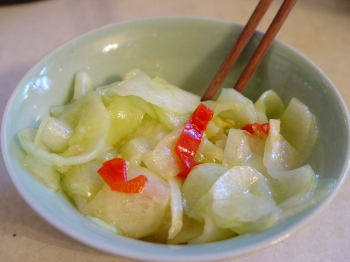 But when the summer hits, the cucumbers start growing, and growing, and growing, and I find that my limited number of plants has produced a massive simultaneous bounty of cukes! This year,to avoid such a situation, I planted a single plant. Unfortunately, it met an early demise when my boyfriend was preparing part of the garden to plant beans and got a little carried away, straying into already planted territory with his hoe. We planted a few lemon cucumbers to replace our little slicer, but they won’t be ready until September. Therefore, I was pleasantly surprised to find that my friend had planted an ambitious amount of slicing cucumbers and was already overwhelmed with the harvest — I now have no fear of missing out on cucumbers this summer.
But when the summer hits, the cucumbers start growing, and growing, and growing, and I find that my limited number of plants has produced a massive simultaneous bounty of cukes! This year,to avoid such a situation, I planted a single plant. Unfortunately, it met an early demise when my boyfriend was preparing part of the garden to plant beans and got a little carried away, straying into already planted territory with his hoe. We planted a few lemon cucumbers to replace our little slicer, but they won’t be ready until September. Therefore, I was pleasantly surprised to find that my friend had planted an ambitious amount of slicing cucumbers and was already overwhelmed with the harvest — I now have no fear of missing out on cucumbers this summer.
In years past, I have planted pickling cucumbers and found myself in my kitchen at late hours of the evening making a simple spicy, garlic dill pickle. Pickling cucumbers have a bitter flavor that seems to suck the moisture out of your mouth, and are really only good for pickling (a friend won’t even grow them for pickling, her strategy is to use slicing cucumbers for pickling instead). I find that pickling in the evening is best because cucumbers ripen during the hottest part of the year, and the last thing I want to do on a 100-degree day is stand over a pot of boiling water next to a pot of boiling brine. Luckily, I did so much pickling in the past two years that I get to skip it all this year and instead enjoy the cool evenings without the mess and heat of pickling activities.
Slicing cucumbers tend to come on and ripen in an unabated manner, providing loads of cucumbers to deal with all at once. If you grew your own cukes and are feeling overwhelmed, have no fear, there are some tasty things you can do with them that will help you consume your bounty and maybe even look forward to more.
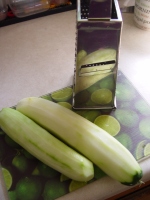
One of my favorite options is Japanese cucumber salad. I often order this when I go to a sushi restaurant as a starter, and I discovered that it is extremely simple. To spice mine up a bit, I add about a tablespoon of fresh diced ginger, 2 teaspoons sesame oil, and about 1 tablespoon of sriracha or diced hot chili peppers (last year we had an abundance of hot peppers, so I froze a gallon bag of them and I am just reaching the end of that supply). I slice my cucumbers after peeling them using cheese-grater slicing blade. My boyfriend has warned me that this blade is highly dangerous, so I pass on that wisdom here: watch your fingers! 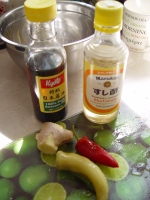 It produces evenly thin-sliced cucumbers that are very easily able to absorb the rice-vinegar and seasoning as they marinate (and it’s easier than getting out the food processor).
It produces evenly thin-sliced cucumbers that are very easily able to absorb the rice-vinegar and seasoning as they marinate (and it’s easier than getting out the food processor).
Another tasty option is tzatziki, a Greek sauce used as an appetizer or in gyros (see Kalyn’s World’s Best Tzatziki Sauce recipe). My variation on tzatziki is to peel the cucumber and then grate it with the fine side of my cheese grater. Instead of chunky sauce, this produces a “stringy” cucumber consistency in the sauce, but I find that it’s easier to neatly get on a piece of pita bread.
A similar dish is cucumber raita, an Indian salad commonly served at my favorite Indian restaurants (in Eugene, Evergreen and Taste of India). With a minty flavor, this dish is refreshing and pairs well with curries and spicy dishes.
One common trick to using cucumbers is to salt them and let them rest and then squeeze the excess moisture out. This is important in the Japanese salad because it allows the cucumbers to better absorb the vinegar mixture. With the tzatziki, the excess moisture would make the sauce significantly more runny.
Another recipe to consider is the Spanish gazpacho. My mom used to make a version of this using about half cucumbers and half tomato. The cold soup is quite tasty on a summer evening, and I’ve heard many describe it as the perfect “summer” dish.
For more ideas, check out this cucumber recipe page, courtesy of Dr. Barbara Cohen, planetary scientist, and apparent cucumber aficionado. I found that Allrecipes.com had 272 cucumber recipes, so there’s certainly no shortage of ideas. Also, you may want to visit this informative site about the different varieties of cucumbers, or this time line of pickle history.
Late season for blueberries in Eugene area
August 9, 2008 § 9 Comments
So last month when we went to pick cherries at Detering’s Orchard we had intended to 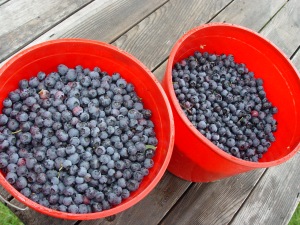 also gather our season’s supply of blueberries. But the late warmth stunted the blueberry crop and when we inspected the bushes available for u-pick there were more green than blue berries. After a few busy weekends recently, we finally had a chance to head out and get our blueberries today.
also gather our season’s supply of blueberries. But the late warmth stunted the blueberry crop and when we inspected the bushes available for u-pick there were more green than blue berries. After a few busy weekends recently, we finally had a chance to head out and get our blueberries today.
I drive by River Bend Farms on Highway 58 frequently, and saw their sign advertising blueberries, but I wasn’t sure if they offered u-pick. So I called them this morning (phone: 520-2561) and Annette informed me that while they don’t offer u-pick berries, she could recommend a few nearby farms to check out: McKenzie River Organics, Adkins Farm, and Blondie’s Blooms.
McKenzie River Organics is near Leaburg (Past mile-post 23 on Highway 126, on right. Open 9-6. 896-3928), and that seemed to be a bit too far of a drive, so we opted  to check out Blondie’s or Adkins. We searched for a phone number for Adkins and couldn’t find a single reference to the farm, but we figured there would be signage along Seavey Loop (Note: I later found a classified ad in the Register Guard, and Adkins’ phone is 579-5431). Blondie’s is along Cloverdale Road between Pleasant Hill and Creswell. Because of a missed exit at 30th St. on I-5, we decided to first go ahead and check out Blondie’s, which Annette had reported had young berry bushes. We arrived at the nursery and blueberry farm and walked around and inspected the plants (mature nursery stock) and bushes, and even had the chance to listen to the fake predatory bird call. But after 26 minutes with no person in sight, we got in the car and drove over to Adkins (we later saw Blondie hocking her berries at the Saturday Farmer’s Market — so it’s possible that while she left the nursery in the hands of her family, they didn’t take their customer-service role seriously).
to check out Blondie’s or Adkins. We searched for a phone number for Adkins and couldn’t find a single reference to the farm, but we figured there would be signage along Seavey Loop (Note: I later found a classified ad in the Register Guard, and Adkins’ phone is 579-5431). Blondie’s is along Cloverdale Road between Pleasant Hill and Creswell. Because of a missed exit at 30th St. on I-5, we decided to first go ahead and check out Blondie’s, which Annette had reported had young berry bushes. We arrived at the nursery and blueberry farm and walked around and inspected the plants (mature nursery stock) and bushes, and even had the chance to listen to the fake predatory bird call. But after 26 minutes with no person in sight, we got in the car and drove over to Adkins (we later saw Blondie hocking her berries at the Saturday Farmer’s Market — so it’s possible that while she left the nursery in the hands of her family, they didn’t take their customer-service role seriously).
We got back in the car and headed west on 58 to Seavey Loop. We immediately saw a little white sign on a telephone pole advertising Adkins Farms blueberries, and we drove along until we saw the sign point to the right down a gravel road (coming from the other direction you would drive straight instead of following Seavey Loop road around a sharp right-hand turn). We drove slowly down the narrow road, passing a couple of philbert and apple orchards, and a small newly planted vineyard. At the end of the road is Adkins Farm, with raspberries, blueberries, and apples. ( 8-5 M-Sat. 579-5431). The farm is a 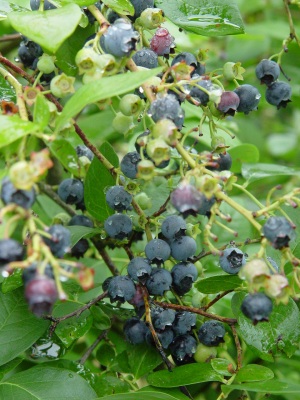 picturesque spot, with neatly mowed grass under the apple trees, a picnic table, and straight long rows of mature blueberry bushes. We followed the signs to the u-pick parking near the shed and checked in and got our buckets for picking.
picturesque spot, with neatly mowed grass under the apple trees, a picnic table, and straight long rows of mature blueberry bushes. We followed the signs to the u-pick parking near the shed and checked in and got our buckets for picking.
I was directed to take note of an interesting paper wasp nest that had formed on a birdhouse on an oak tree (they observed my camera), and then we were off to pick. The berries were $1.50/lb, and we filled our buckets a little over 3/4 full each and walked away after about forty minutes with $9.50 in berries. We will be rinsing them and freezing some for later and using the rest in some pancakes and perhaps, if boyfriend is lucky, a pie.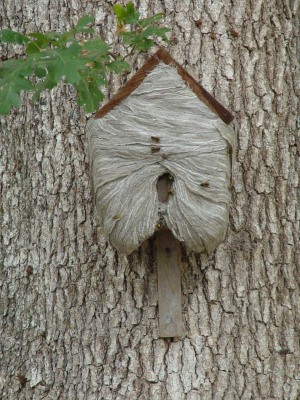
The blueberries should remain available for picking at local farms through the end of August. Also, if you go to Adkins, bring a container to take home your fruit in — they just provide the buckets for picking and a scale to weigh them, but no carry-home containers.
Lane County U-pick Blueberry Resources:
As we were searching for a phone number for River Bend Farms we came across this handy list of Oregon roadside farm stands which is a great resource for these kinds of local food excursions!
The Oregon Blueberry Commission provides a listing of member farms in Lane County (and other counties), but it is incomplete. They also provide some interesting blueberry recipes.
Adkins Heritage Farm, Seavey Loop Road (follow the signs); 8-5 M-Sat. 579-5431
The Berry Patch Farm near Leaburg, no spray, open M-Sat, 8-6
McKenzie River Organics, near Leaburg (Past mile-post 23 on Highway 126, on right); open 9-6, 896-3928
Some good friends of mine recommend Green-Hill-Aire’s Organic u-pick operation that is close to Eugene (28794 Hillaire Street); 688-8276. I called, they are going to be open 8/16 and 8/17 from 8-6; but they’ve been closed for two weeks because they had been picked out. Call for availability.
Miller’s in Springfield on Camp Creek Road is also organic; Mon 8-7 Tues-Sat 8-5. 746-1760
Bear Fruit: Mon.-Sat., 9-5 Harrisburg – follow signs. 995-3445
Greenbrier Farm: 83524 Rattlesnake Rd. , Pleasant Hill
Cherry picking at Detering’s
July 17, 2008 § 5 Comments

Royal Anne cherries at Detering Orchards
On Monday we decided that we had better get our annual u-pick cherry escapade done with as the following two weeks are pretty packed with other activities. We drove out on the scenic route through Coburg to Detering’s.
As I stepped out of the car, I noticed a familiar face of a fellow food-lover, Eugenia who wondered aloud how I may have recognized her (the photo on her blog helped). We had a quick chat, and then my boyfriend and I grabbed our buckets and headed out to the glorious cherry trees.
We decided we really only needed to pick one bucket this year as we still had about five bags of cherries from last year (I can hardly believe it). We prefer the black sweet cherries to the more tart (but still sweet) Royal Anne’s that were also available. We made pretty quick work of the picking — not so quick that we didn’t get to enjoy consuming some of the deliciousness. But the 95 degree temperatures made the experience moderately less pleasant than a crisp morning might offer.

Black sweet cherries at Detering Orchards
We drove home and got to the fun part that is cherry pitting. With our special pitting device we set up newspapers on the floor and furniture. We put a plastic garbage sack in a paper bag that we would pit the cherries over. Then we washed the fruit and began the manual labor of pitting each cherry, tossing the pit into the plastic bag and putting the fruit in a big stainless bowl. We divvied up the labor because a few years ago I committed to pitting about 20 lbs of cherries all by myself and I got tendonitis in my wrist from the repetitive motion — beware the hazards of cherry pitting!
Once the batch was pitted, we got out the zippered freezer bags and filled them up and put them in the freezer. When I have a delicious black-cherry smoothie in December, I’ll be glad I made the effort and happily forget about how sticky the entire experience was.
Detering’s is open from 8 – 5 daily, and if you don’t want to venture out to pick your own fruit, their farmstand offers the available fruit plus some additional products that aren’t currently ripe. The u-pick cherries and blueberries are available currently for $1.25/lb (I believe that’s a bit up from last year when I’m pretty sure the price was less than $1/lb). We picked up a large basket of peaches that were not from the orchard (although, they were about to begin picking the peaches near the blueberry patch). We attempted to u-pick some blueberries to round out our freezer stores, but the bushes weren’t very ripe yet so we determined that we’d have to wait a couple of weeks for a more prime time to pick. Visit their website for an update on what is available for u-pick throughout the summer and fall.
Any time you go to a u-pick orchard it is advisable to bring a cooler with ice or at least a box to put your fruit in. Not all farms provide containers for you to take home your fruit in, so it’s a good idea to come prepared.
Half of the shitakes sold in the US are from China
July 2, 2008 § Leave a comment
Did you know that half of the shitake mushrooms sold in the US are imported from China? I didn’t, not at least until I heard this story on NPR’s Morning Edition. The mushrooms sit in a cargo ship for two to three weeks before arriving at a wholesale market in San Francisco, CA, and then get distributed down the chain to restaurants and grocery stores.
In Eugene, we have the privilege of being able to buy our Shitakes at the Lane County Farmer’s Market every week. And when it comes to a product that often sells for $12/lb, maybe Shitakes that aren’t local are something you can forgo entirely.
The NPR story was inspired by the recent outbreak of Salmonella that was thought to be linked to tomatoes, but which now seems a bit harder to pin down. This national news has made more people try to be more aware of where their food comes from. The FDA website on the outbreak featured a list of “safe states” from which tomatoes that had not been linked to the outbreak could be procured. This information then led consumers to wonder how they could know what state the tomato on their store shelves had come from.
Locally, PC Market of Choice lists the local farm that they source their local produce from. I bought a bag of mixed lettuce last week ($6.99/lb) that PC buys from Hey Bayles! farm. As I have previously mentioned, Red Barn Natural Grocery in the Whiteaker also sells local produce when available. Sundance Natural Foods carries local produce as well, within a quick bike ride to most residents of South Eugene. I don’t make it into The Kiva that often, but for those who are frequently downtown, it also carries local products when available.
It’s great to be in a location with such a great variety of choices for local food!
Event Announcement:
I just found out about this yesterday, but tonight, I’ll be headed over to the Laurel Valley Educational Farm at the Northwest Youth Corps headquarters in Southeast Eugene (map). The folks from Slow Food Eugene are hosting a Potluck at 5 PM.
Saving endangered food
June 30, 2008 § 1 Comment
Last night I was happily making a stir-fry (using fresh snap peas and chard from my garden, as well as frozen carrots from last year along with some non-local additions…) and I was listening to the Splendid Table on my “local” NPR affiliate, KOPB.
Toward the end of the show, Lynne interviewed Gary Nabhan on the “RAFT” movement. RAFT is short for Renewing America’s Food Traditions, which is also the title of Nabhan’s book. If you visit the Splendid Table Website this week you can scroll to the “Heard on the Show” section and click on the word RAFT to hear the interview.
I hadn’t heard of this project before, and it sounds like something that a lot of foodies would be interested in.
U-Pick strawberries near Eugene
June 30, 2008 § 5 Comments
So, I am a geek and I looked for how people found this blog during this past week… and many people used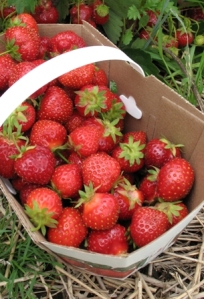 the search terms for u-pick strawberries. Now granted, the last post was about fresh local strawberries. And I mentioned U-pick… but I was talking about Cherries! So people were led to the site, and I didn’t have the information they were looking for: so sorry!
the search terms for u-pick strawberries. Now granted, the last post was about fresh local strawberries. And I mentioned U-pick… but I was talking about Cherries! So people were led to the site, and I didn’t have the information they were looking for: so sorry!
To make up for it, here are the farms I know about that currently offer u-pick strawberries.
River Bend Farms west of Pleasant Hill on Highway 58 is open for picking (even on the 4th of July). Their Craigslist ad provides all the useful info: phone, hours, driving directions.
The farms below had classified ads in the Register Guard (If the farms ask where you heard about them, tell them it was the Register Guard — newspapers need all the support they can get these days):
Bear Fruit: Harrisburg (Coburg Rd.) U or We pick. Mon-Sat 9-5. Phone: 995-3445
Evonuk’s: Seavy Loop, U-pick strawberries (Open 8 AM until they’re all picked). 747-0065.
Harry’s Berries: Coburg. U-pick. Mon-Sat 9am till picked out. 344-0742
Hansen’s: Creswell. Picked & U-pick. Organically grown available Open 9 Mon-Sat. 895-3082
Herrick Farms: Walterville. U-pick and picked. 741-1046
Lee Farms: Junction City. Senior discount. No spray. Picked or U-pick. 556-1332
Lone Pine Farms: River Road, Junction City. 688-4389.
Happy to help the farmers spread the word, and help all those web searchers find what they’re looking for. Let me know if I left anyone out!
Photo by scol22 and posted at www.sxc.hu.
June strawberries
June 22, 2008 § Leave a comment
I was very excited when I got to the Lane County Farmer’s Market this weekend and discovered that the strawberries had arrived in force. At least five booths boasted flats and flats of the ripe red berries, and the price was about $3 per pint. The unusually cool spring we had delayed the onset of the berries, and I was delighted to see them at the market.
I picked up two particularly lush looking pints of strawberries, with no specific intention other than enjoying them. I also purchased a loaf of whole wheat Levain from Marche Provisions.
So this morning my boyfriend suggested that we make pancakes with strawberries cooked in… I thought about it and thought the strawberries would have too much moisture and they would make soggy pancakes. Instead, I suggested we just make pancakes and serve them with sliced strawberries and whipped cream. He countered with french toast and strawberries. It was settled, we would have a locally-sourced breakfast.

The whipping cream was actually sugar-free Cool Whip, so it wasn’t really that local or natural (but it reduced the caloric content of the meal); it could be substituted by local Lochmead fresh-made whippingcream to enhance the local content. The eggs were local, and the milk in the batter was Lochmead 2%. The vanilla was organic and was contained in a reused bottle that was refilled at my neighborhood’s Red Barn Natural Grocery. Lastly, that cute little garnish of mint was local — from our mint pot on the front porch.
I was also excited to find the first pints of cherries at the market — my reminder that it is time to go to the orchards for u-pick. But, after putting in a call to the folks at Detering Orchards today, I discovered that the cool spring has caused the cherries to delay as well, with u-pick unavailable until after July 7th.
Economics of home-grown veggies
June 9, 2008 § 2 Comments
I heard a story repeated on KOPB this past week about home gardens, and how the resurgence in backyard gardens is occurring in the Pacific Northwest in response to the world food crisis, as well as the higher cost of food at grocery stores.
Last week, the Wall Street Journal ran an article about this phenomenon, and featured a couple of different families partaking in a “Victory Garden” endeavor: The Vegetable Patch Takes Root.
Following these stories, today, I read a blog from Huffington Post contributor Laura Vanderkam, entitled “The Case Against the Victory Garden.” Vanderkam has been writing about the new “home economy” and has taken the examples given in the WSJ article and conducted her own economic critique of home-grown vegetables. She argues that time is money, and that your backyard garden may not be a financial boon when the amount of time to tend the plot is considered. Vanderkam says:
“In Barbara Kingsolver’s best-selling memoir, Animal, Vegetable, Miracle, she calculated that the value of the vegetables, chickens and turkeys her family harvested during a year of labor on their small farm was $4,410. That’s a fair chunk of change. But it comes out to $85 a week – including meat. If a part-time farm contributes $85 a week in meat and produce, it’s unlikely that a 10-by-12-foot vegetable patch is going to produce more than $25 of weekly savings. At 10 hours a week, that comes out to less than minimum wage – which explains why gardening remains a hobby for most people.”
I agree with the premise: Time is money. And scale is important — a small plot may not produce enough food to really be a financial help to a family, but as plots size is scaled up so is productivity, and thus the dollar value of the food produced.
One of the figures cited in the WSJ article and Vanderkam’s post, was that it takes about 10 man hours for a 10 x 12 foot plot. My thought is that seems incredibly high. I usually tend my garden, a 15 x 30 foot plot two to three times per week for no more than two hours each time. Once the garden is in, this is reduced to 30-minute visits and an occasional intense-weeding session of about 1-hour. If I was an ultra-busy mother with children to tend to, this would be more inconvenient, certainly. But at this point the alternative activities I would be participating in could hardly be considered “work,” (like watching TV or reading blogs). But as a result of this article, I will try to more accurately track the amount of time we spend on our plot and try to provide an economics perspective on the value of produce harvested.
Let me know if you have anything to share on this economics front. I’d be interested in hearing from anyone who has started gardening for economics reasons, or anyone who stopped growing their own produce because of the amount of time and relatively small proceeds from a home-garden.
 In fact, that’s why we want to share the “gospel” with others and encourage people to think of eating a bit differently. Where our food comes from has burgeoned in the public consciousness with the Salmonella outbreak, and it has been a repeated theme in media outlets. As I was making a stir-fry last night (from reading my posts you might think that’s all we eat around here… but it’s coincidence, I assure you) I was listening to
In fact, that’s why we want to share the “gospel” with others and encourage people to think of eating a bit differently. Where our food comes from has burgeoned in the public consciousness with the Salmonella outbreak, and it has been a repeated theme in media outlets. As I was making a stir-fry last night (from reading my posts you might think that’s all we eat around here… but it’s coincidence, I assure you) I was listening to